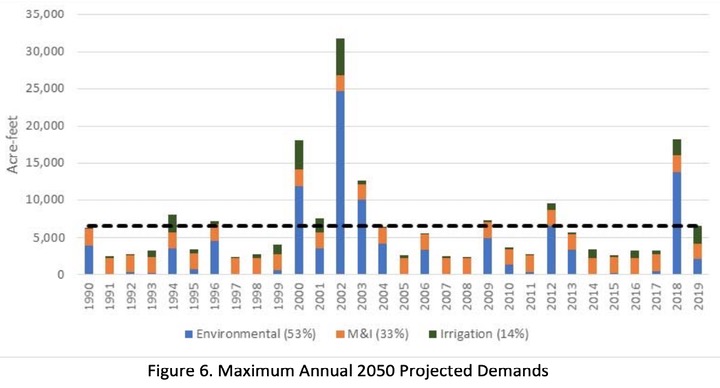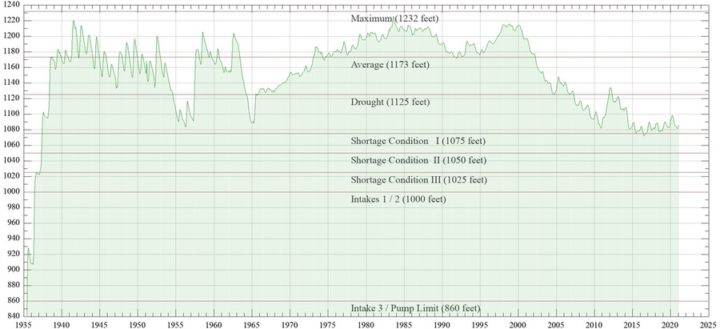Yesterday in Part Seven of this editorial series, we shared an essay by San Juan Water Conservancy District (SJWCD) Board President Al Pfister, offering a certain perspective on Colorado water issues in general. Mr. Pfister also noted that SJWCD board is currently considering the best plan of action for addressing a fast-approaching June 21, 2021 deadline, and he invited Daily Post readers to view the recent ‘West Fork Water Rights’ analysis drafted by Lakewood-based Wilson Water Group.
You can download the draft report on this SJWCD web page.
A previous SJWCD board stipulated changes to those West Fork water rights, including the stipulation that a future 24,000 acre-foot reservoir, originally designated to be built at the foot of Wolf Creek Pass in Mineral County, must be relocated by June 21 of this year. To put that size reservoir into perspective, it would store enough water to supply the average treated water demand of the Pagosa Area Water and Sanitation District (PAWSD) for about 18 years, even if not a drop of rain fell during that entire period.
That particular piece of data — 18 years — does not appear in the Wilson Water Group report. It’s my own calculation, using my pocket calculator. Instead of describing reservoir sizes into an easy-to-understand form like “18 years worth of water without a drop of precipitation”, it’s typical for “water demand” reports in Colorado to use graphs like this one in the Wilson Water Group report:
Note: I currently serve as an appointed volunteer on the San Juan Water Conservancy District, serving the taxpayers of Archuleta County. This editorial series expresses my own research and opinions, and does not necessarily reflect the opinions of any other SJWCD Board members, nor the decisions and policies of the SJWCD Board as a whole.
SJWCD President Al Pfister and I sometimes agree on water policy issues, and sometimes we don’t. The taxpaying public — the folks who ultimately paid for the Wilson Water Group report — deserves to hear all sides of a public policy issue, so I’m pleased that President Pfister was willing to share his perspective in the Daily Post.
The Wilson Water Group (WWG) report has not yet been officially accepted by the SJWCD Board, and no official decision has yet been made concerning the West Fork water rights. After reading through the report a couple of time, and after having a chance to ask questions of the WWG team about the report’s conclusions, I would summarize the report’s most important findings this way:
1. The rather large West Fork Reservoir is currently designated for a location that include the current the Bootjack Ranch. SJWCD has already stipulated that the reservoir will not be built at that location. That’s a given.
2. The only practical location in Archuleta County suitable for a 24,000 acre-foot reservoir is on the Running Iron Ranch northeast of downtown Pagosa, owned jointly by PAWSD and SJWCD.
3. PAWSD and SJWCD already have stipulated rights for an 11,000 acre-foot reservoir on the Running Iron Ranch.
3. PAWSD does not appear to have a need for additional reservoir storage between now and 2050.
4. We are not seeing a growing demand for agricultural water… in fact, just the opposite.
5. The only way SJWCD could justify a new reservoir on the Running Iron Ranch would be to demonstrate a pressing need for environmental/recreational water in the San Juan River. But neither the West Fork Reservoir rights, nor the the Dry Gulch Reservoir rights currently allow the release of water for environmental/recreational augmentation.
6. So it would mean a trip back to water court to change the rights, if SJWCD wants to assert a demand for environmental/recreational water.
7. There is no way SJWCD can demonstrate (with a straight face) a demand for 24,000 acre-feet worth of environmental/recreational water, so WWG suggests we stick with the Dry Gulch size if we move forward with a reservoir.
They didn’t actually tell us to abandon the West Fork rights in so many words, but that’s the conclusion I’ve reached, reading between the lines.
A couple aspects to this whole issue that WWG did not address (partly because they were not asked to address them) are the cost of any reservoir, the cost of water court filings, and voter/taxpayer attitudes.
Would the Archuleta County voters approve an 11,000 acre-foot reservoir — at a cost of many millions of dollars — so that inner-tubers and fly fishermen can enjoy a couple of extra weeks recreating on the San Juan River?
Would it be wise to spend some unknown amount of tax dollars defending, or seeking to make changes to, SJWCD’s West Fork water rights in water court?
Those seems to be the most important questions left unanswered by the 22-page Wilson Water Group report. The SJWCD will have to take a stab at answering those questions as best we can, at our special work session on March 29.
I started this editorial series by posting a working title: “Dragons, Unicorns, and Colorado’s Water Crisis.” I’m not sure if dragons or unicorns ever walked on the earth, but somehow became extinct. It’s very possible they are completely mythological. We have very little scientific evidence either way. The primary evidence of their possible existence is found in old paintings and tapestries.
Based on my research, over the past decade into Colorado water issues, I find very little scientific evidence that we are facing a existential crisis, in terms of water supplies in Pagosa Springs, or in Colorado as a whole. There’s much more evidence that California, Nevada and Arizona are facing a true crisis — if they expect to continuing abusing the Colorado River the same way they’ve been doing all these many years.
“Water demand” is a highly flexible computation, but it’s not always treated that way by the water industry.
I’m right now drinking my second cup of coffee. I could have had only one cup instead. I could have easily cut my “demand” in half.
That’s pretty much what happened in Pagosa Springs over the past 20 years. According to data from PAWSD, per person consumption of treated water dropped from about 186 gallons per day in 2001, down to about 105 gallons per day in 2019.
That particular data was not included in the Wilson Water Group report.


